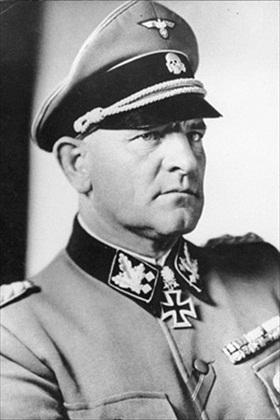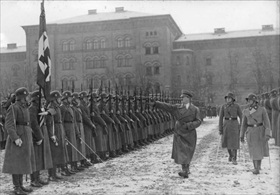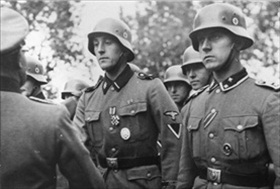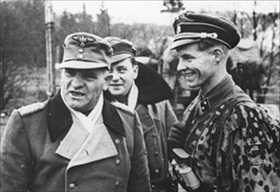HITLER SHAKEN BY VIENNA’S SURRENDER
Berlin, Germany • April 14, 1945
Austria’s capital Vienna fell to the Red Army on April 13, 1945, and the Soviet News Agency announced it to the world on this date in 1945, the same day Adolf Hitler, in his Fuehrerbunker under the rubble of the Reich Chancellery in Berlin, learned of it. The Austrian front had been defended by one of the fiercest German SS (Schutzstaffel) tank armies under the command of SS-Oberstgruppenfuehrer (the equivalent of a Colonel General in the German Army) Josef “Sepp” Dietrich, whom Hitler had entrusted with the December 1944 Ardennes Offensive, popularly known as the Battle of the Bulge. (The Ardennes Offensive, focusing on the rapid seizure of the Belgian port of Antwerp, aimed at splitting the British and American forces and possibly forcing a second “Dunkirk” and potential British withdrawal from the war.)
At 5 ft. 7 in, Dietrich was a burly, stocky Hitler loyalist from the get-go. He was a participant in Hitler’s failed Munich Beer Hall Putsch of November 1923 and commanded the firing squad that executed many senior Sturmabteilung (SA) leaders implicated in the Roehm Putsch of 1934 (“Night of the Long Knives”). He had an office and living quarters in the Reich Chancellery, where he occupied a room in the Fuehrer’s suite. A likeable, courageous front-line soldier, Dietrich commanded the 6th Panzer Army during the siege of Vienna, an army that by then was exhausted after combat in the Ardennes and Hungary, to say nothing about being outgunned and outmanned defending Austria’s capital. With gallows humor honesty, he told his HQ staff in early 1945: “We call ourselves Panzerarmee 6 because we have only six panzers [tanks] left.”
On hearing the news of Vienna’s fall—Dietrich had pulled the remnants of his armored units out of the city on April 13—Hitler fell into a towering rage, ordering Dietrich and his men in a radio message to remove the cuff bands (unit names) on their uniforms as a sign of their disgrace. Dietrich telegraphed back that he would rather be shot than carry out the order and did not communicate it to the rank and file. A myth arose that he and his officers filled a chamber pot with their medals and prepared it to be sent to Hitler cowering in his underground bunker.
Dietrich surrendered himself and remnants of his army to an infantry division attached to Gen. George C. Patton’s U.S. Third Army on May 8‑9, 1945, in Austria. After the war Dietrich was falsely implicated in the Malmedy (Belgium) massacre of 84 American POWs and sentenced to life imprisonment (reduced to 25 years), but he was paroled (for the second time) in February 1958.
SS-Oberstgruppenfuehrer Josef “Sepp” Dietrich (1892–1966)
 |  |
Left: Josef “Sepp” Dietrich rose from being Adolf Hitler’s chauffeur and chief bodyguard (Chief of Fuehrer Security) to one of Nazi Germany’s most decorated soldiers and commanders. His rise in rank took off after his SS guards provided a seven-man shooting party during the “Night of the Long Knives” (Nacht der Langen Messer, June 29–30, 1934). His role in killing a number of SA leaders earned him a nineteen-month sentence in postwar Germany.
![]()
Right: Hitler and Dietrich review the Leibstandarte (Regimental Body Guard) Adolf Hitler, December 17, 1935, in Berlin. Hitler had tasked Dietrich with creating the SS Watch Battalion-Berlin, which later became the Leibstandarte SS Adolf Hitler. Though retaining the designation “regimental” (Standarte), the LSSAH eventually exceeded a strength of 20,000 men (a division). In 1943 the LSSAH became known as the 1st SS Panzer Division Leibstandarte SS Adolf Hitler. The LSSAH’s symbol was a skeleton key in honor of Dietrich, its first commander. (“Dietrich” is the German word for skeleton key or lock pick.)
 |  |
Left: Dietrich commanded the 1st SS Panzer Division Leibstandarte SS Adolf Hitler in the Battle of Normandy (Operation Overlord, June 6 to mid-July 1944). On August 6, 1944, Dietrich became the sixteenth recipient of the Knight’s Cross of the Iron Cross with Oak Leaves, Swords, and Diamonds, the Wehrmacht’s highest decoration, awarded only 27 times during World War II and only twice to a member of the SS. Dietrich next assumed command of the 5th Panzer Army, then that of the newly created (Fall 1944) 6th Panzer Army, which saw service in the Ardennes Offensive (Battle of the Bulge), Hungary, and Austria. Here Dietrich is seen four years earlier in France (June 21, 1940), awarding metals to the men of his Leibstandarte SS Adolf Hitler. The LSSAH was one of three divisions that were the nucleus of the Waffen-SS. The other two were Das Reich and the Totenkopf (Death’s Head), the latter division supplying guards to Germany’s concentration and death camps.
![]()
Right: Dietrich meeting front-line soldiers on the Eastern Front, January 1945. After his arrest in Austria on May 9, 1945, Dietrich was convicted by the U.S. Military Tribunal at Dachau in 1946 in connection with the Malmedy (Belgium) massacre, where 86 American POWs were executed by a group of SS men (Kampfgruppe Peiper) during the Battle of the Bulge. He was paroled in 1955 but was convicted in a West German court for crimes he really did commit in 1934 (Roehm Putsch).
Short Documentary on Josef “Sepp” Dietrich and the Soldiers of the Leibstandarte SS Adolf Hitler
![]()

 History buffs, there is good news! The Daily Chronicles of World War II is now available as an ebook for $4.99 on Amazon.com. Containing a year’s worth of dated entries from this website, the ebook brings the story of this tumultuous era to life in a compelling, authoritative, and succinct manner. Featuring inventive navigation aids, the ebook enables readers to instantly move forward or backward by month and date to different dated entries. Simple and elegant! Click
History buffs, there is good news! The Daily Chronicles of World War II is now available as an ebook for $4.99 on Amazon.com. Containing a year’s worth of dated entries from this website, the ebook brings the story of this tumultuous era to life in a compelling, authoritative, and succinct manner. Featuring inventive navigation aids, the ebook enables readers to instantly move forward or backward by month and date to different dated entries. Simple and elegant! Click 











